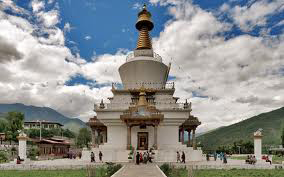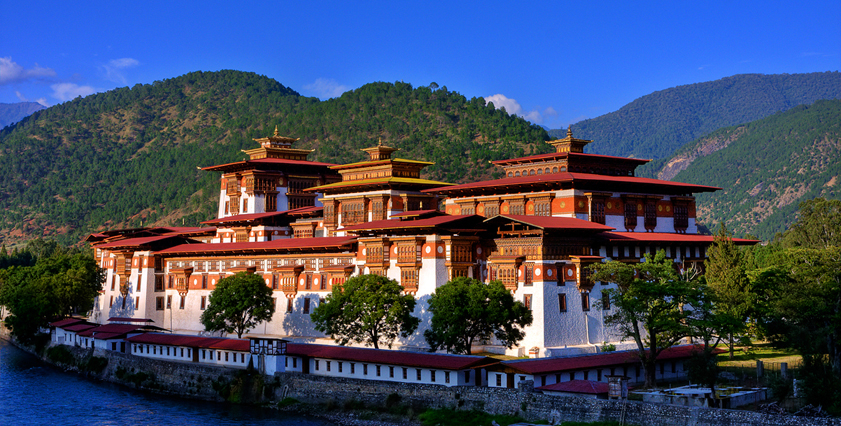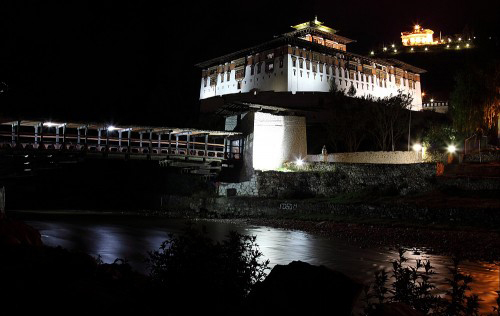
[ Thimphu Festival Tour | Thangbi Mani Festival Tour | Jambay Lhakhang Drup Tsechu Festival Tour | Black Crane Festival Phobjikha Tour | Punakha Domchey Festival Eight Nights Tour | Punakha Domchey Festival Ten Nights Tour | Chorten Kora Tsechu (arrive Paro, Depart Paro) | Chorten Kora Tsechu (arrive Paro, exit India) | Chorten Kora Tsechu (arrive India, exit Paro) | Gom Kora Tsechu (enter Paro, exit Paro) | Gom Kora Tsechu (enter Paro, exit India) | Gom Kora Tsechu (enter India, exit Paro) | Paro Tsechu Festival Tour | Paro Tsechu Festival 7 Dzongkhags Tour | Paro Tsechu Festival Tour with Druk Path Trek | Ura Yakchoe Festival Tour ]
Punakha Domchey Festival Eight Nights Tour
- Western & Central Bhutan
Dzongkhags Covered: Paro, Thimphu, Punakha, Bumthang, WangdueDuration: 8 Nights 9 Days
Itinerary Outline:
Day 1: Arrive Paro. Head to Thimphu.
Day 2: Tour of Thimphu
Day 3: Punakha (Punakha Festival)
Day 4: Punakha to Bumthang
Day 5: Bumthang
Day 6: Bumthang to Gangtey
Day 7: Gangtey to Paro
Day 8: Paro
Day 9: Depart Paro
Punakha Domchey:
This festival includes masked dances; and spectacular costumes made of yellow silk or rich brocade, often decorated with ornaments of carved bone. For certain dances, the monks wear masks which represent fearsome deities, animals or skulls of human beings. This festival takes place in the first month of the lunar year and ends with ‘Serda’, a magnificent procession which reenacts an episode of the war against the Tibetans in the 17th century. Punakha Dromche festival is unique for being the only festival with this reenactment of the war. Dromches (festivals) generally include dances and this festival is dedicated to Yeshe Gompo (Mahakala) or Palden Lhamo, the two main protective deities of Drukpas (Drukpas = means people of Druk land or Bhutanese). The religious dances performed during the festival are called ’Cham’ and there are a large number of them, Incidentally, chams have been banned in neighbouring Tibet by the Chinese government. These dances can be grouped in three categories- Instructive or Didactic Dances; Dances that Purify and Protect a Place from Demonic Spirits; and Dances that Proclaim the Victory of Buddhism.
Detailed Itinerary:
Day 1: Arrive Paro. Head to Thimphu.
Elevation 2,320 m. Welcome to Bhutan, the Land of the Thunder Dragon. Touching down at Paro International Airport, you will be greeted by your guide upon exiting the arrival hall. Today, we will take it easy to acclimatise to the altitude. Go on an hour's relaxed drive, all the way following the river, to Thimphu. Check in to the hotel and have your first taste of Bhutanese cuisine and some light sight-seeing like the vegetable market in Thimphu. Visit the Heritage Museum- Dedicated to connecting people to the Bhutanese rural past though exhibition of artifacts used in rural households. Also the Textile Museum where you can witness the art of traditional weaving. Five miles from Thimphu, on a lofty ridge, stands Semtokha Dzong, the oldest fortress in the Kingdom.
Day 2: Tour of Thimphu
 Elevation
2,320 m. Thimphu Dzong - the largest Dzong, is also the seat of the office
of the King of Bhutan. Visit the National Memorial Chorten (left)-
which was built in memory of the late (Third) King Jigme Dorji Wangchuck.
Go to the Paper making factory - see the art of Bhutanese paper making
(Bhutanese paper is different from normal paper). The Centenary Farmers’
Market, a vegetable market and where most of the Thimphu population seems
to congregate. It is on the banks of the Thimphu river, the Wangchhu.
Here villagers from the valley and other nearby places come to sell their
agriculture products. Afternoon drive to Punakha via Dochula Pass. Stop
here briefly to see the 108 chortens built by the present Queen Mother
of Bhutan, Ashi Dorji Wangmo Wangchuck, to commemorate Bhutan’s
victory over the Indian militants hiding in Southern Bhutan and to liberate
the souls lost. Drive time 3 and a half hours.
Elevation
2,320 m. Thimphu Dzong - the largest Dzong, is also the seat of the office
of the King of Bhutan. Visit the National Memorial Chorten (left)-
which was built in memory of the late (Third) King Jigme Dorji Wangchuck.
Go to the Paper making factory - see the art of Bhutanese paper making
(Bhutanese paper is different from normal paper). The Centenary Farmers’
Market, a vegetable market and where most of the Thimphu population seems
to congregate. It is on the banks of the Thimphu river, the Wangchhu.
Here villagers from the valley and other nearby places come to sell their
agriculture products. Afternoon drive to Punakha via Dochula Pass. Stop
here briefly to see the 108 chortens built by the present Queen Mother
of Bhutan, Ashi Dorji Wangmo Wangchuck, to commemorate Bhutan’s
victory over the Indian militants hiding in Southern Bhutan and to liberate
the souls lost. Drive time 3 and a half hours.
Day 3: Punakha (Punakha Dromche)

Elevation 1,300 m. Punakha Dzong - Built in 1637, the Punakha
dzong (above) continues to be the winter home for the clergy,
headed by the Chief Abbot, the Je Khenpo. It is a stunning example of
Bhutanese architecture, sitting at the fork of two rivers (Mo Chhu and
Pho Chhu- the female and the male rivers), portraying the image of a medieval
city from a distance. The Dzong was destroyed by fire and glacial floods
over the years but has been carefully restored and is today a fine example
of Bhutanese craftsmanship.
Dromches (festivals) generally include dances and this festival is dedicated to Yeshe Gompo (Mahakala) or Palden Lhamo, the two main protective deities of the Drukpas (Drukpas = means people of Druk land or Bhutanese). Punakha Dromche take place in the first month of the lunar year and ends with ’Serda’, a magnificent procession which reenacts an episode of the war against the Tibetans in the 17th century. Visit the Khamsum Yulley Namgyal Chorten built by the Third Queen Mother, Ashi Tshering Yangdon Wangchuck. This Chorten is a splendid example of Bhutanese architecture and art and is the only one of its kind in the world. It has been built over eight and a half years and its details have been drawn from religious scriptures.
Day 4: Punakha to Bumthang
Drive time 7 hours. Elevation 4,000 m. Chhimi Lhakhang - A 20 minutes walk across terraced fields through the village of Sopsokha from the roadside to the small temple located on a hillock in the centre of the valley below Metshina. Lama Ngawang Chogyel (the elder brother of Lama Drukpa Kuenlay) built the temple in the 15th century after the ‘Divine Madman’ Drukpa Kuenlay built a small chorten there. It is a pilgrim site for barren women. Pass Wangdue, one of the major towns and district capital of Wangduephodrang in Western Bhutan. Located south of Punakha, Wangdue is the last town before Central Bhutan. The district is famous for its fine bamboo work and its slate and stone carving. We will pause to view the ruins of the Wangduephodrang Dzong. Built in 1638, Wangdue Dzong is dramatically perched on the spur of a hill and overlooks the confluence of the Tsang Chu and Dang Chu rivers. Unfortunately, the Dzong was razed by fire in June 2012. On route is Trongsa but we will visit Trongsa on our way back to Gangtey from Bumthang on Day 6.
Day 5: Bumthang
Elevation 2,600 m to 4,000 m. This is one of the most spectacular valleys in Bhutan and also the heartland of Buddhism in Bhutan. It is an area with a wide variety of fauna and flora. Guru Rinpoche and his lineage of Tertons (treasure finders) making Bumthang his home have led to more than 40 temples being built in this peaceful valley. In the morning, we will hike to the Tamshing Goemba built in 1501 by the Buddhist saint Pema Lingpa. We will also visit Kurjey Lhakhang, one of the most sacred monasteries in Bhutan. Built by Guru Rinpoche in 1652, it houses a rock with his body imprint. Legend has it that Guru Rimpoche manifested as a Garuda to defeat the demon Shelging Karpo who had taken the form of a white lion. We will also visit Jambay Lhakhang, built in 659 by the Tibetan King Sontsen Gampo to pin down a demoness who was obstructing the spread of Buddhism. Come October, the Jambay Lhakhang Drup is one of the most colourful festivals in Bhutan. Jakar Dzong - pitched on a high ground overlooking the town junction was built as a monastery in 1549 by the great grandfather of the Shabdrung. It is now used as the administrative centre for Bumthang district. In the afternoon, we will hike up to Thangbi Valley, crossing a suspension bridge to visit the Thangbi Lhakhang built in the 14th Century via an unpaved road.
Day 6: Bumthang to Gangtey
Drive time 5 hours. Elevation 3,000 m. On route to Gangtey is Trongsa, the ancestral home of the ruling dynasty. Trongsa, literally "New Town" in the Dzongkha language, is where the current monarchy had its origin in Bhutan. Each King in the line of succession has held the post of Trongsa Penlop or Governor before donning the Raven Crown. The foundations of Trongsa Dzong were laid in the 16th century by Pema Lingpa. The Dzong flourished during the 17th century under Shabdrung Ngawang Namgyal. With its massive structure, its wall looming high above the winding Mangde Chhu Valley, the Dzong commands the east-west road. Functioning as a watchtower, the Tower of Trongsa safeguarded Trongsa Dzong during centuries of political unrest and war. Since the 17th century this fortress castle has been both the centre of political power and a place of Buddhist worship. From here the roots of Bhutan's Monarchy, established in 1907, originated when the more or less independent local principalities were unified into one strong state. Incidentally, there is a book on this prominent Dzong written by Christian Schicklgruber entitled The Tower of Trongsa, Religion and Power in Bhutan.
Day 7: Gangtey to Paro

Day 8: Paro
Elevation 2,280 m. Drugyal Dzong - A morning drive north of Paro valley brings us to the ruins of Drugyal Dzong. Built in 1647 by the great Shabdrung Ngawang Namgyal, father and unifier of medieval Bhutan, the Dzong was destroyed by an accidental fire and left in ruins as an evocative reminder of the great victories it was built to commemorate. Explore the ramparts and re-live the memories of a glorious past. Taktsang Monastery - A one hour hike to the cafeteria is also a vantage point from where you can enjoy a stunning view of the monastery. Prayer flags adorn the cliffs and this is also where Guru Padmasambhava first landed on the back of a tigress in the 8th century, there being no airport at the time. Kyichu Lhakhang - After a sumptuous local lunch, we will retrace our steps to visit Kyichu Lhakhang, one of the oldest temples in Bhutan.
Day 9: Depart Paro
Elevation 2,280 m. After breakfast, we will transfer to Paro airport for our flight and bid a fond farewell to the Kingdom of Bhutan.
As festival times are the most popular times for visitors to come to Bhutan, flight seats and hotel rooms will be on high demand. Book early to avoid disappointment.
| |
BACK TO FESTIVAL TOURS MAIN PAGE |
